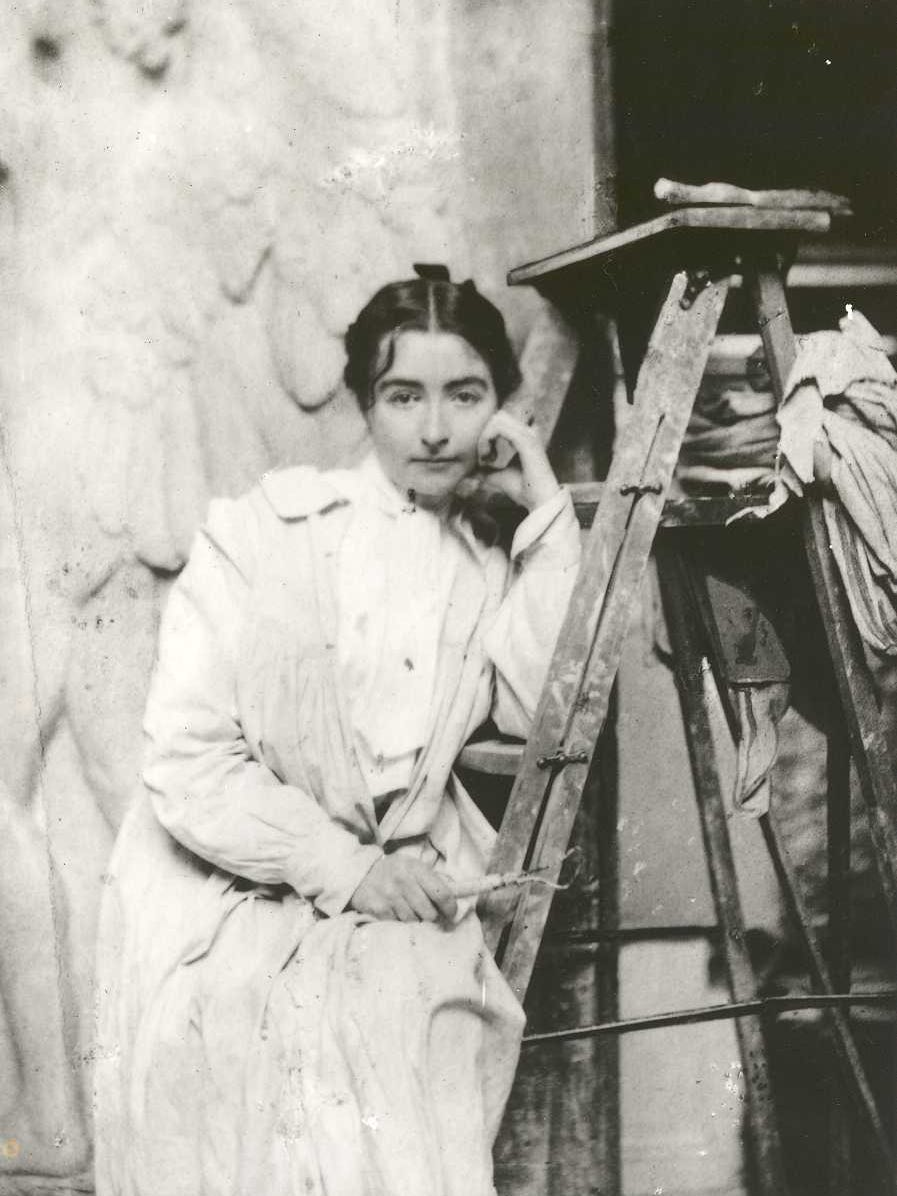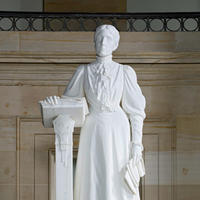More about Helen Farnsworth Mears
Works by Helen Farnsworth Mears

Contributor
If there is one thing that Wisconsinites love, it's Wisconsin, and never has there been a sculptor more willing to demonstrate this fact than Helen Farnsworth Mears.
Mears was born in Oshkosh in 1876 and was the daughter of a surgeon and Wisconsin's first published poet, Natalie Wildwood. So, from the get-go, art and anatomy were part of Mears' life, and as such, she was encouraged to pursue sculpture from a young age. She would win her first award at the age of nine at the Winnebago County Fair, for a bust of Apollo.
As a teenager, she came under the wing of a famous New York sculptor named Augustus Saint-Gaudens, and shortly thereafter was commissioned to create a piece for the 1893 World’s Columbian Exposition in Chicago. In the name of her home state, she created an awesome, nine-foot tall marble goddess, complete with an eagle companion, called Genius of Wisconsin. Following this success, Augustus Saint-Gaudens made her his official assistant. This not only gave her a chance to work in the busiest studio in New York, but also allowed her to travel with Saint-Gaudens to study in Europe at the Academie Julian and Academie Vitti.
Even after being fully immersed in all the art world had to offer, Mears retained an impassioned love for her home state. Unfortunately, Wisconsin did not share the same sentiment. In 1910, Mears was contracted to draw up sketches for a statue that would crown the Wisconsin capitol building. However, for some reason or another, the drafts submitted by this world-class sculptor were found to be unsatisfactory to her patrons, even after she made changes in response to some of their criticisms. When Mears began working on a third draft (one that would compete with other artists), she turned to the fellow sculptor Daniel Chester French for advice. But in a dramatic twist, Mears' proposal was rejected in favor of none other than French’s designs, whom she didn’t know was also trying to get the gig. Mears was predictably enraged, and left her home state, returning to live in New York with her sister, tragically being added to the long list of Dames Done Wrong in art history.
Mears’ final years were lived in what is described as intense poverty. She would die in 1916 of influenza, a short 5 years after being rejected by the state she so loved.
Sources
- Website Contributor “HELEN FARNSWORTH MEARS” Wisoconsin Women Making History viewed on 09/22/2020 https://womeninwisconsin.org/helen-farnsworth-mears/
- Website Contributor “Helen Farnsworth Mears (1872 - 1916)” Museum of Wisconsin Art viewed on 09/22/2020 https://wisconsinart.org/archives/artist/helen-farnsworth-mears/profile…
- Website Contributor “HISTORICAL ESSAY: Mears, Helen Farnsworth (1872-1916)” Wisconsin Historical Society viewed on 09/22/2020 https://wisconsinhistory.org/Records/Article/CS1635

Contributor
Helen Farnsworth Mears is the definition of a child prodigy.
Mears even received awards for her creations from her childhood, like her bust of the sun god Apollo which she created when she was only 9 years old and won a prize at the Winnebago State Fair. As a toddler, Mears created sculptures from pieces of bread. Her subject of choice? People and animals. This child prodigy made a mark in her birthplace of Oshkosh, Wisconsin, where there is now an art contest named after her: the Helen Farnsworth Mears Art Contest.
Mears was born Nellie, but decided Helen was a better fit. The change of name came in honor of her aunt Helen Farnsworth, who put up the cash to have her niece study at the Art Institute of Chicago. That’s one way to pay back a debt! The Mears family approved of this venture, being as they were an incredibly talented bunch themselves. Her parents, Elizabeth and John Mears, encouraged Helen and her sisters to develop their creative skills. While Helen picked up a chisel, sister Mary dealt with words, and their oldest sister Louise became an illustrator. Take note, parents. This is how you raise three artistic daughters.
Young and with more talent in her little finger than most of us have in our entire bodies, Mears won her first commission from the State of Wisconsin. She sculpted The Genius of Wisconsin for the Chicago World’s Fair, which depicts a woman and a winged eagle. The sculpture is now on display at the Wisconsin State Capital.
Mears and her sister Mary, the writer, set up a studio in New York. It was here that she received commissions to sculpt men of note, such as George Rogers Clark, Dr. William T.G. Morton, and Edward MacDowell, though one of her most notable works is her sculpture of the suffragist Frances E. Willard. This depiction of Willard would come to find its home in the National Statuary Hall Collection of the U.S. Capitol Building, and was the first sculpture of a woman to receive the honor.
Sharing a studio made the siblings closer than ever, and they assisted one another in their pursuit of art. Then, shockingly, Helen Mears died at the age of 43, most likely from heart failure due to malnutrition and possibly influenza. It is said that her health and financial well-being had both declined after losing a commission to create a sculpture for the dome of the new Wisconsin State Capitol Building, the project instead going to Daniel Chester French.
Sources
- Dimmick, Lauretta, Hassler, Donna J., Tolles, Thayer, American Sculpture in the Metropolitan Museum of Art: A Catalogue of Works by Artists born between 1865 and 1885. New York: The Metropolitan Museum of Art, New York, 1999.
- Gardener, Albert Ten Eyck, American Sculpture: A Catalogue of the Collection of the Metropolitan Museum of Art. Greenwich, CT: New York Graphic Society, 1965.
- Lemke, Daphne, “Women’s history month: these 11 Wisconsin women made an impact on the state, and the nation,” Oshkosh Northwestern, March 10, 2020. Accessed September 25, 2020. https://www.thenorthwestern.com/story/life/2020/03/10/wisconsin-history…
- Levy, Hannah Heidi. Famous Wisconsin Artists and Architects. Oregon, WI: Badger Books, Inc, 2004.
- Scannell, Randy. A Year in the Life of a Boomtown: 1884, Florence, Wisconsin. United States: n.p., 2004.
- Titus, William A.. History of the Fox River Valley, Lake Winnebago, and the Green Bay Region. United States: S.J. Clarke Publishing Company, 1930.
- Voss, Lisa, “Mears art contest celebrates art created by youths with reception Sunday at Public Library,” Oshkosh Northwestern, March 8, 2018. Accessed September 25, 2020. https://www.thenorthwestern.com/story/news/local/community/2018/03/08/m…
- Wisconsin State Journal, “Helen Farnsworth Mears (1872-1916), March 3, 2017. Date accessed October 8, 2020. https://madison.com/wsj/helen-farnsworth-mears-1872-1916/article_5a8c70…
Featured Content
Here is what Wikipedia says about Helen Farnsworth Mears
Helen Farnsworth Mears (/mɪərs/; December 21, 1872 – February 17, 1916) was an American sculptor.
Check out the full Wikipedia article about Helen Farnsworth Mears











